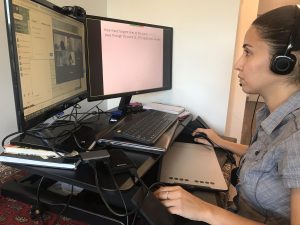7I am currently one of the workshop teachers of this first-year math course. My responsibilities included design and delivery of the practice problems in workshops, as well as invigilating the midterms and final exams. I spent 4hr/week in the workshops and ~2hr/week for developing the problem sets, answering students’ questions and concerns and prepare the handouts; which adds up to total of 48hr/term for ~60 students in the first-year Science and Applied Science program at UBC.
- Teaching Approach
For each session, I select a series of practice problems relevant to the material being covered in the lectures. Upon introducing each problem to the class, I send students into breakout rooms of 3-4 students/breakout room and give them time to set up the problem and start the solution; while floating between the breakout rooms and providing clarifications if needed. After reconvening into the main room; I provide a clear explanation of how to translate the word problems to mathematical equations and set up the solution with the help from students. Then, I solve the problem to the whole class and answer any other questions before moving to the next problem. I tend to be flexible with my problem sets and take the class where the student questions and discussions go, and still ensure that the students are equipped with the necessary tools and math knowledge to succeed in the weekly quizzes. Although the number of problems covered in each workshop is lower than any traditional tutorial session, I think these fewer number of practice problems have higher quality in terms of students’ actual learning. I believe this would help student build confidence in their technical knowledge and critical thinking capabilities. The rest of problems not covered in the class are provided to the students as handouts with solutions posted later on in separate file. Students are highly encouraged to try and solve those extra practice problems first by themselves and reach out for clarifications if needed and then only as a final resource look at the provided solutions.
- Challenges

This course is being offered online due COVID19 pandemic and one of the biggest challenges is to create a sense of community in the virtual setting. This challenge is even more serious in the first-year setting where a lot of students are new to the university environment and don’t know many of their peers (especially given the large size of MATH 100 class). To this end, I have decided to take advantage from one of the zoom built in feature and send students to breakout room where they are encourage to discuss the problems and help each other set up the solution for the practice problems. I believe seeing their peers take initiative in helping others and explaining the concepts to those in need, would be a great way of creating sense of community among first years. During this activity, I as the teacher of the session, would take the role of a moderator and float between different breakout rooms, giving tips, providing hints and correcting the misunderstandings if any.